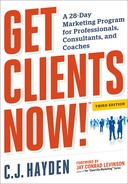Day 1
Saturday is an excellent day to begin your Get Clients Now! program. Close the door, turn off the phone, and bring out your completed Action Worksheet from Chapter 5. Make an enlarged copy of the blank Tracking Worksheet in Figure 6-2, or download the worksheet from the book’s companion website at www.getclientsnow.com. You can print the worksheet and fill it out by hand, or use one of the electronic versions and keep it on your computer, tablet, or smartphone.
Fill in the dates on the top line and the information in Column 1. See Lee Greenback’s partially completed worksheet (Figure 6-1) for an example. On the top line, write the calendar dates of your working days for the next month. If the coming Monday were March 4, for example, you would label the first ten columns on your worksheet 3/4–3/8 and 3/11–3/15, skipping the Saturday and Sunday rest days in between. Next, write in Column 1 the Success Ingredients from your Action Worksheet with your chosen target dates for completing them. Then add your ten Daily Actions, Program Goal and Special Permission.
Award yourself a starting score on each of your Success Ingredients and your Program Goal. Are you starting from zero on your Success Ingredient projects and the goal you set for the month, or have you already made some progress? On Lee Greenback’s worksheet, he gave himself a starting score of 50 percent on “market niche definition,” believing he was already halfway there. On his “10-second introduction,” he had done some work, but needed more, so he scored himself at 25 percent. For “live networking venues,” Lee had yet to do anything, so he started at zero.
To give yourself an accurate score now and throughout the program, you may need to quantify your Success Ingredient projects. For Success Ingredients like “networking venues” or “referral partners,” consider the question, “How many is enough?” If you’re unsure, review the appropriate chapter in Part III for your chosen stage of the Universal Marketing Cycle. Write the number you choose on your worksheet, as Lee did for his networking venues. If you have chosen a more intangible Success Ingredient, such as “networking skills” or “telemarketing skills,” score yourself intuitively. If zero equals “phone phobic” and 100 percent means “expert telemarketer,” where would you rate yourself today? Would you like to be at 100 percent by the end of the program, or would 75 percent satisfy you? If it’s the latter, write down “telemarketing skills at 75 percent,” so you know what you’re aiming for.
Figure 6-2: Blank Tracking Worksheet

Now award yourself a starting score on your Program Goal. As described in Chapter 3, this is a numerical target for clients, contracts, appointments, billable hours, total revenue, or new prospects. You may be starting at zero, or you may have made some progress already. Either way, be honest with yourself, and be specific about what you are counting. Is a new client anyone who schedules his first appointment, or does this count only after the person shows up for it? Is your total revenue what you bill this month, or what you actually collect? Base your score on a way of measuring that you can track each week and will make this goal truly meaningful for you.
Keep the Tracking Worksheet where you will be sure to see it first thing Monday morning. Are you ready to make a commitment to the program you have designed for yourself?
Thought for the day: Jay Conrad Levinson, author of the Guerrilla Marketing series, often says the following when asked about his work: “I hate to admit this, but mediocre marketing with commitment works better than brilliant marketing without commitment.”
